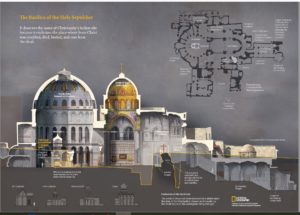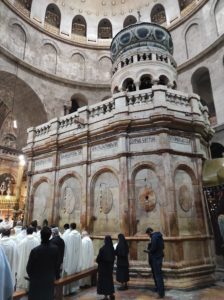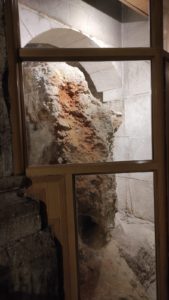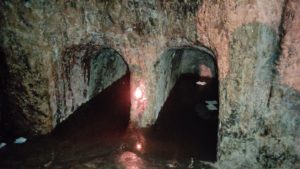More than one pilgrim who has visited the Holy Sepulcher is perplexed by the complexity of that church, enclosed within a group of connected buildings and in which the multiple chapels appear to displace the importance of the two main places in the history of Salvation: Calvary, where Jesus died for humanity, and the empty tomb, where he rose again from the dead.
The reason for this, is that the church of the Holy Sepulcher, as it exists today, is the result of a long history of construction, destruction, and restauration. In order to avoid losing oneself in the complexity, it is convenient to visit the monument accompanied by the texts of the Gospel.
The indications about the geographical context of the death and resurrection of the Lord that the gospels provide are few, but they are quite precise.
Jesus was taken to a place called Golgotha to be crucified (Jn 19:17). Because it was the habitual place where death sentences were carried out, it was outside the walls of the city, but only a short distance, and probably near a main thoroughfare or one of the gates to the city. Saint John tells us that the reason for the sentence could be read by many people (Jn 19:20).

Basilica of the Holy Sepulchre, Footsteps of Our Faith

Basilica of the Holy Sepulchre, Footsteps of Our Faith
It was not a hill but more like an isolated hillock within an abandoned rock quarry. This is why the current chapel at Calvary is not more than three or four meters above the ground level of the basilica. The old quarry had been used to build the walls of Jerusalem in times of king Hezekiah and the prophet Isaiah (at the end of the VIII century b.C.). The rock cutters had left this portion of rock aside as they could not extract any quality blocks from it. Today, the visitor to the Holy Sepulcher can see the fissured rock of Golgotha, enclosed behind a window. On this rock, discarded by the builders, the Cross was erected (cfr. Matthew 21:42 // Psalm 118:22).

Golgotha Rock, Basilica of the Holy Sepulchre, photo by Henri Gourinard
Another surprising detail for pilgrims: the short distance between the sepulcher of Christ and Calvary. Saint John writes: “Now, in the place where he had been crucified there was a garden, and in the garden a new tomb …” (Jn 19:41). On its western flank, the quarry had been converted into a burial yard. Tombs from the time of Jesus can still be seen around the Holy Sepulcher. Behind the Edicule enclosing the Tomb of Christ, in the Syrian chapel, there is a niche in the wall that leads to a dark chamber. When illuminated by an oil lamp, one can see several other horizontal openings carved into the stone, in the shape of bread ovens. Two tombs stand out, and so popular piety has identified them as the tombs of Joseph of Arimathea and of Nicodemus, two members of the Sanhedrin and secret disciples of Jesus, who went before Pilate to request the dead body of their master. The existence of these tombs from the time of Jesus constitutes archeological evidence that the place chosen by Constantine to build his basilica was outside the city walls when Jesus was crucified, because in Jewish cities, the dead were always buried outside the city limits.

Tomb of Joseph of Arimathea, photo by Henri Gourinard
Constantine and Helen, after learning the exact location of Golgotha and of the Tomb, had the first basilica of the Holy Sepulcher built. The architects had to demolish the pagan temple erected on that spot by emperor Hadrian. They also bulldozed the rock around Christ’s Tomb and the place of the Crucifixion. The Tomb was later protected within a marble edicule and surrounded by an immense rotunda with pillars and a dome.
Many generations of pilgrims throughout history have lined up around this edicule hoping to pray even a few seconds at the Tomb of the Lord.
By Henri Gourinard
